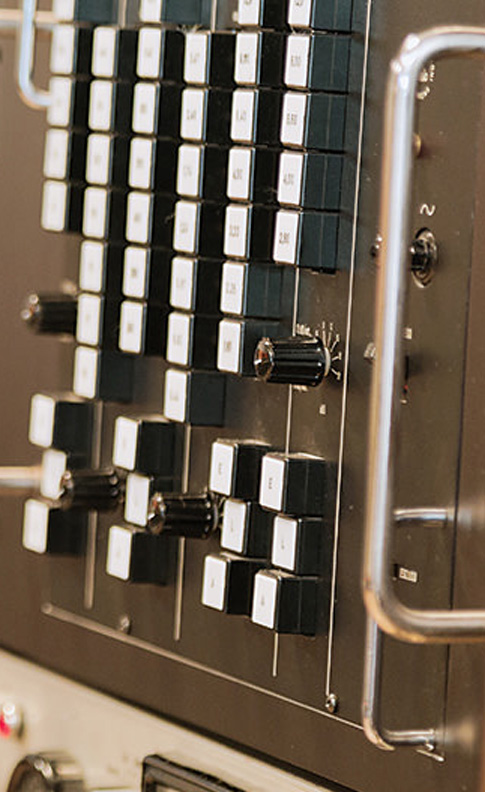AudioScape is run by Chris Yetter in Daytona, Florida, and currently produces six different compressors and an EQ, all based off of classic, well-known designs – including an SSL style bus compressor and British Zener-style diode compressor! Focusing on no compromise remakes while hitting affordable price points, these boxes are all hand built in the USA. This review will home in on the AudioScape Opto Compressor, akin to the '60s era Teletronix LA-2A [Tape Op #26].
Just in case you've been under a rock and are not familiar, the LA-2A is an optical tube leveling amplifier brought to life by James Lawrence II via his company Teletronix, out of frustration of having to ride the gain to keep the signal level consistent for broadcast. It is an easy to use compressor with only a Peak Reduction knob, a Level knob and Compressor/Limiter switch. The compression ratio changes based on the incoming program material, which is directly tied to the intensity of light the photoresistor "sees." Think about that for a second – light is made directly from the audio's voltage and frequency, almost instantly! This is why I always find this circuit so interesting; the opto-attenuator uses a photoconductive cell optically coupled to an electroluminescent light source. Referencing an article written by James Lawrence from 1964, he explained that filament lamps, cathode ray, and neon light sources were attempted as the level-controlling element before settling on what is now known as the T4 opto cell. The original LA-2A was discontinued in 1969 with the introduction of the LA-3A.
The Opto Compressor is housed in a 3 rack space unit height steel enclosure with a time period matched front panel, Davies-style knobs, and a vintage-inspired VU meter. To me, the most impressive part of the build is AudioScape's own recreation of the T4B opto-attenuator. They are hand built to the same tradition as the originals, using replica EL Panels (in Aviation Green; the original color) with high-grade photocells and NOS Allen-Bradley carbon comp resistors. These components are all critical to the sound of the compressor, as the physics of the T4B have a direct correlation to the response and compression curves. Cinemag input and output transformers are wound to replicate the originals. Throughout the rest of the build you will find hi-quality components, including Panasonic polyester caps, Cornell Dubilier Polypropylene caps, and half watt carbon comp resistors. On the back you'll find a Neutrik XLR input and output, plus a TRS stereo link. It houses a 120 V power supply with a Hammond power transformer. The Opto Compressor employs "a complete NOS tube complement in the audio section for the most colorful, vintage-inspired sonics," along with a single JJ 12AX7 tube in the sidechain that does not pass audio. The circuit is not assembled on a turret board but on a PCB, which has allowed AudioScape to design for the lowest noise specs. This unit holds true to the original with 40 dB of total gain, and a fixed 10 ms attack time with a release time ranging from .5 to 5 seconds.
The Opto Compressor is fantastic on the sources generally associated with an optical compressor – bass and vocals – due to its multi-stage release. In this type of circuit 50% of the release is done in less than a second whether compressing or limiting. This coupled with the smooth attack allows for the lack of "pumping" you might typically find with such high gain reduction in other compressors of this type. Having the HF knob on the front panel instead of the back is a welcomed addition – I never climb behind my racks to change anything! The HF adjustment allows you to filter out low frequency content to the T4B cell as you turn the knob counterclockwise, focusing the compression from squashing too much low end. This can also help with de-essing. The CineMags seemed to thicken/deepen the sound like you would expect from vintage transformers. The Opto Compressor worked surprisingly well on acoustic guitar, with a slight sheen added from the tubes and its smooth top end. But how does it compare to similar competitors? The AudioScape is a 3 rack space unit height compared to many two-space height LA-2A clones, the NOS tubes in the Opto Compressor are truer to the original design with high-quality components throughout, and it is hand-built! I really noticed a performance difference when I hit the AudioScape hard – it reacted much more musically than other competitors in the Opto Compressor's range. I did not get the boxiness or smallness that I get when driving other compressors. This five to ten percent difference in sound quality is on par with original LA-2As that I've used.
I'm impressed with the AudioScape Opto Compressor. It has the vibe I'd expect from an LA-2A with its smooth, transparent compression – handling soft sources beautifully, and serves admirably when pushed hard. The HF control on the front panel offers the advantage of curtailing the low end from being compressed. The price point is more than competitive for a hand-built unit that uses excellent components. If you're in the market for an LA-2A-style optical compressor, it would be foolish not to give the AudioScape your consideration.




_disp_horizontal_bw.jpg)